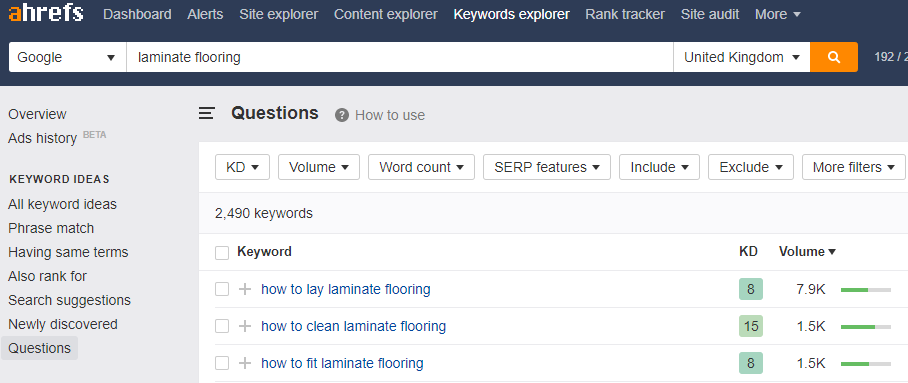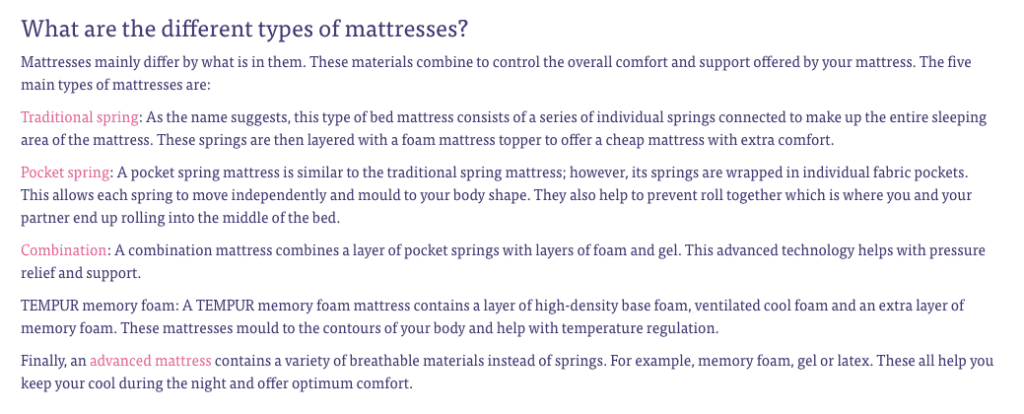Enhanced copy is essentially your regular copy and then some.
This will usually be around 700+ words at the bottom of the page and will explore a topic in depth. While traditional SEO copy is usually quite ‘salesy’ and tends to describe the company’s products or services, enhanced or expanded copy is more of a user-focused, helpful resource.
For example, a category page of ‘mattresses’ on a furniture site would have expanded copy delving deep into any questions associated with mattresses. Such as the average size of a mattress or what to consider when choosing your comfort grade.
This type of copy is important for every industry. Our guide runs through why this is so important, how to create DIY enhanced copy for your site and demonstrates its success through a case study with Dreams Beds.
Why should you use enhanced copy?
Enhanced copy is intended to provide important information to potential customers. This could include how to use a certain product, how to care for it and other things to consider before purchase. Think of it as a manual that answers any questions users might have. This is far from traditional SEO copy which is more likely to discuss how amazing the product is and why the customer needs it.
Enhanced copy became a focus in Google’s recent algorithm update, which prioritises fulfilling the user’s intent and building great content. Having extended copy allows you to provide further information that ultimately makes the user more informed and educated before making a decision.
Related: What Does Google Mean by High-Quality Content? – A Full Breakdown
This makes the website a more trusted resource as the content has considered several aspects. For these reasons, having expanded copy is, therefore, more likely to increase authority and overall ranking.
Related: Google Algorithm Update Reinforces the Important of Content to Rankings
If done properly, when somebody Googles a certain question, enhanced copy could lead them to your business. Take for example ‘how to clean laminate flooring’ which has an average organic search volume of 1,600 a month. A flooring website which discusses maintenance in their copy is more likely to be seen by those potential customers than a website which only discusses the different shades of laminate flooring they offer.
How to write enhanced copy
If you’ve decided to give enhanced copy a go, try the following steps:
1. Determine your keywords
Sites like Moz and SEMrush will help you determine the best keywords to target. Try and spread these throughout the copy without keyword stuffing.
2. Include other relevant keywords
It’s helpful to consider semantic clustering and include the subtopics or clusters that might fall under that category. For example, if you’re writing copy for a page targeting ‘beds’ you might want to include terms like ‘children’s beds’, ‘super king beds’ or ‘bunk beds’. This allows further opportunity for internal linking, because you can link to the pages that sell these specific products and increase your rankings throughout.
3. Identify your questions
Determine the most commonly asked questions about that topic through sites like SEMrush or the ‘People also ask’ section on Google. This will show you questions which you need to answer within your copy. For instance, using the previous laminate flooring example, ‘how to lay laminate flooring’ or ‘how much laminate flooring do I need?’ are commonly asked questions. Answer the Public is a very helpful tool to help you determine these questions.
We love to use the Keywords Explorer on ahrefs which brings up all the related questions with search volumes for any related questions. You can alter the country next to the search bar at the top. When you click on Questions down the left-hand side, a list of questions with their search volumes shows up. You can use these to help inform your headers.

4. Determine your H tags
The best headings are commonly asked questions which include the keywords you’re trying to target. Take for example, if ‘vinyl floors’ was one of your keywords, ‘Do I need underlay for vinyl floors?’ would be a good heading. With most of your H tags, it’s also best to use common sense and think of obvious questions customers may be asking when they land on that page. If in doubt, try and explain what the subject is, for example ‘what is engineered wood flooring?’. The questions identified from the previous step should give you a good foundation for content.
5. Answer questions as clearly and concisely as possible
Doing this increases your chances of acquiring the featured snippet on Google and growing your traffic. For example, if the question is ‘what is laminate flooring?’ start your answer with ‘laminate flooring is…’. This will also help with NLP (natural language processing), as it’s clear you’re answering the question directly.
Case study: Dreams Beds
A successful example of the effects of enhanced copy can be seen with Dreams Beds. Dreams came to us wanting to improve their organic performance, as competitors ranked above them for several terms, for example, ‘single beds’, ‘memory foam mattresses’ and ‘king beds’. The reason for this was that competitors had richer and more user-focused content.
We got to work by updating the copy on roughly 60 pages across the site, making sure we fulfilled the user’s intent and answered any questions they might have. Here’s an example of some of our enhanced copy for the ‘mattresses’ page.

After copy was added, rankings drastically improved. For example, Dreams achieved 1st position for several terms including ‘storage beds’, ‘headboards’, ‘ottoman beds’ and ‘memory foam mattress’. There was even a 284% increase in visibility within a month of updating their ‘single beds’ page with enhanced content. Results of this enhanced copy on impressions can also be seen below.

Read more about or work with Dreams Beds.
To summarise, it’s plain to see the success enhanced copy can have not only in terms of SEO but also by providing useful and informative content to potential customers.
Need help with your enhanced copy? Get in touch with our team of experienced writers.
How to write enhanced copy
- Determine your keywords
Sites like Moz and SEMrush will help you determine the best keywords to target. Try and spread these throughout the copy without keyword stuffing.
- Include other relevant keywords
Consider semantic clustering and include the subtopics or clusters that might fall under that category. For example, if you’re writing copy for a page targeting ‘beds’ you might want to include terms like ‘children’s beds’, ‘super king beds’ or ‘bunk beds’. This allows further opportunity for internal linking because you can link to the pages that sell these specific products and increase your rankings throughout.
- Identify your questions
Determine the most commonly asked questions about the topic through sites like SEMrush or the ‘People also ask’ section on Google.
Answer the Public is a very helpful tool to help you determine these questions as is the Keywords Explorer on ahrefs which brings up all the related questions with search volumes for any related questions.
- Determine your H tags
The best headings are commonly asked questions which include the keywords you’re trying to target. Take for example, if ‘vinyl floors’ was one of your keywords, ‘Do I need underlay for vinyl floors?’ would be a good heading.
- Answer questions as clearly and concisely as possible
Doing this increases your chances of acquiring the featured snippet on Google and growing your traffic. For example, if the question is ‘what is laminate flooring?’ start your answer with ‘laminate flooring is…’. This will also help with NLP (natural language processing), as it’s clear you’re answering the question directly.
